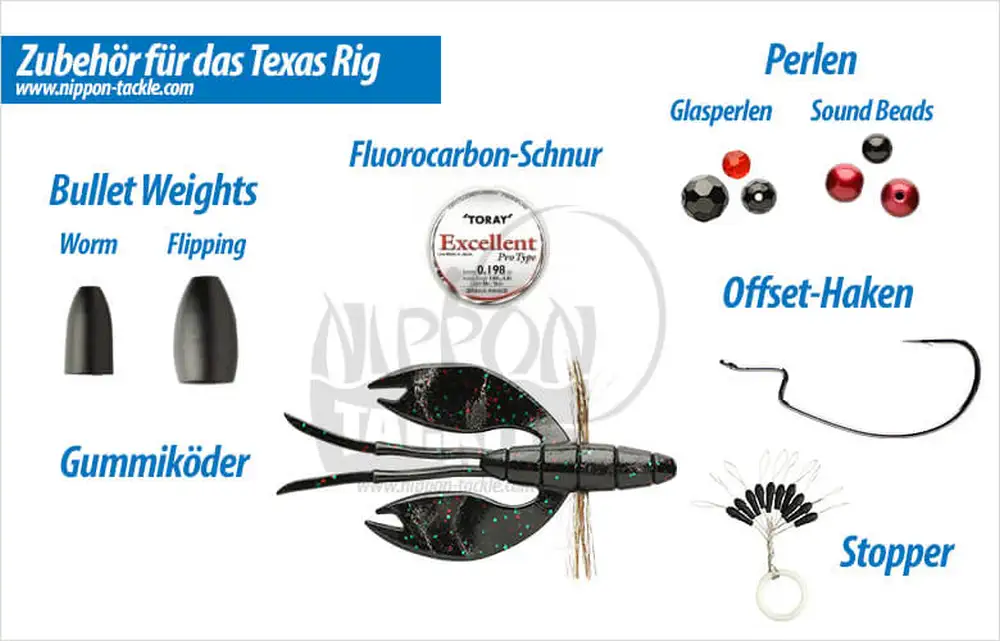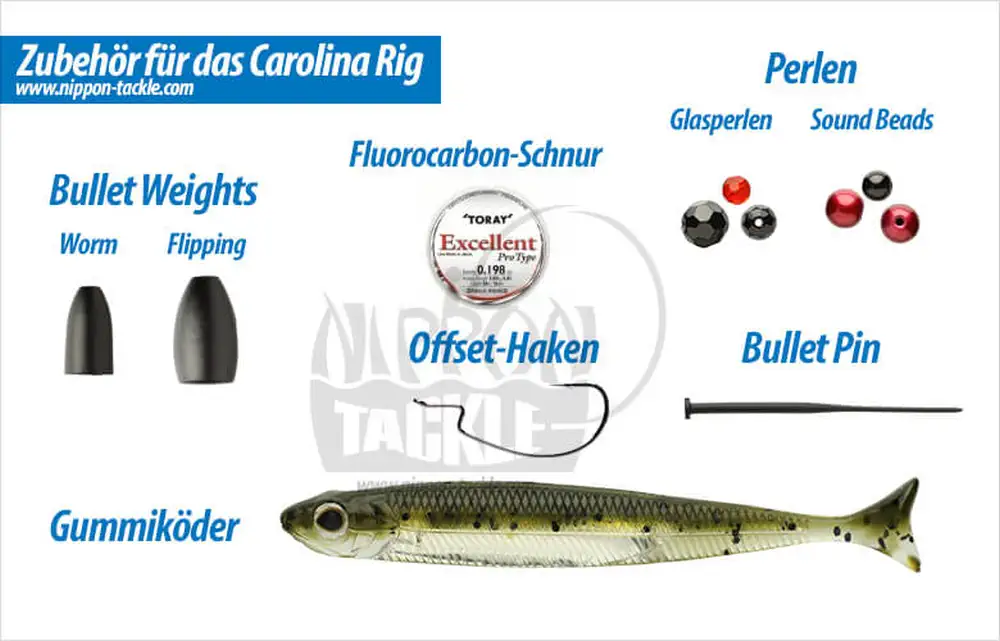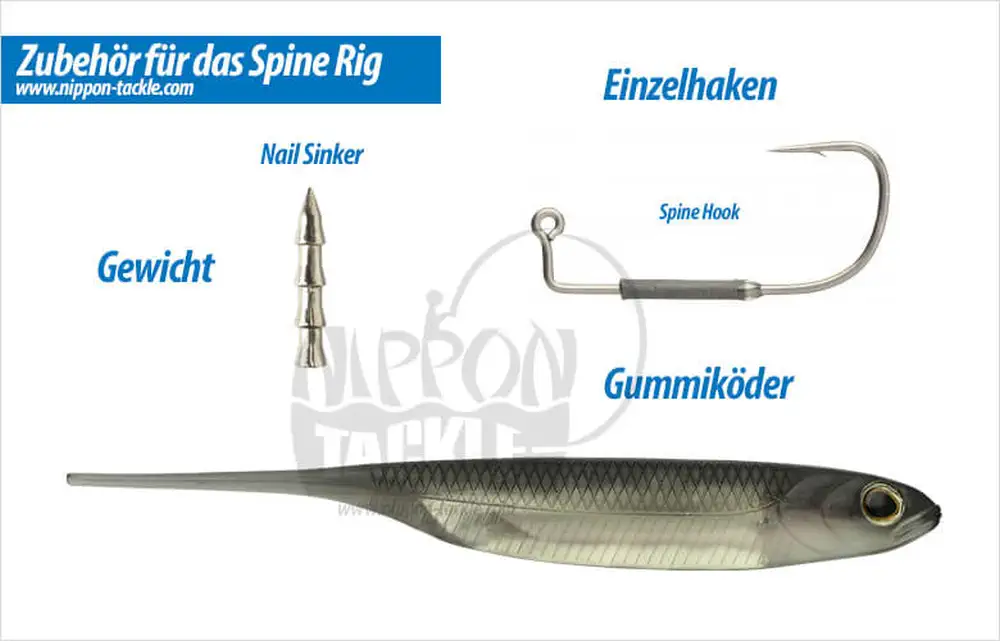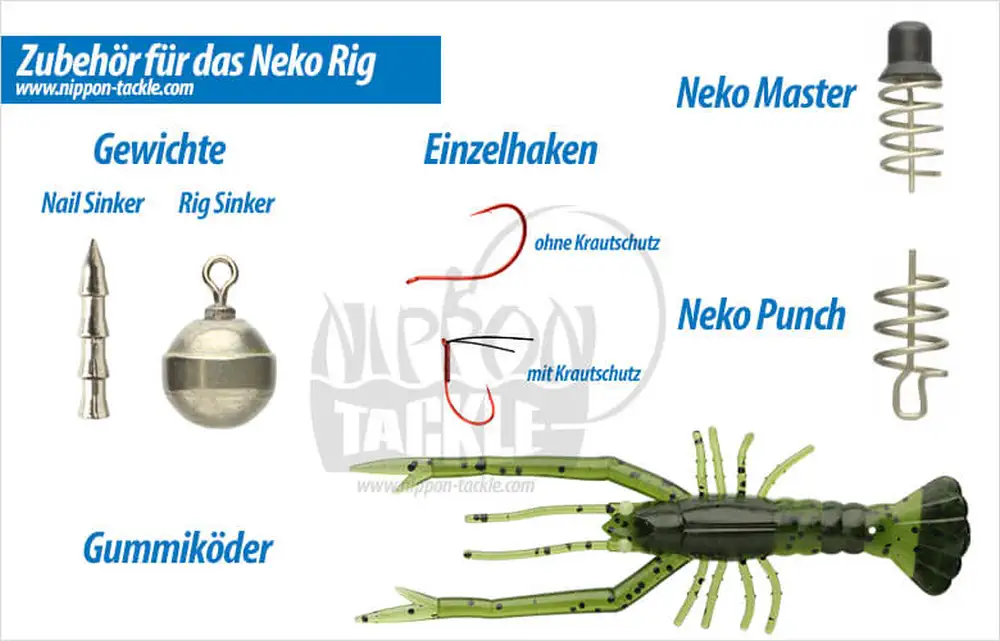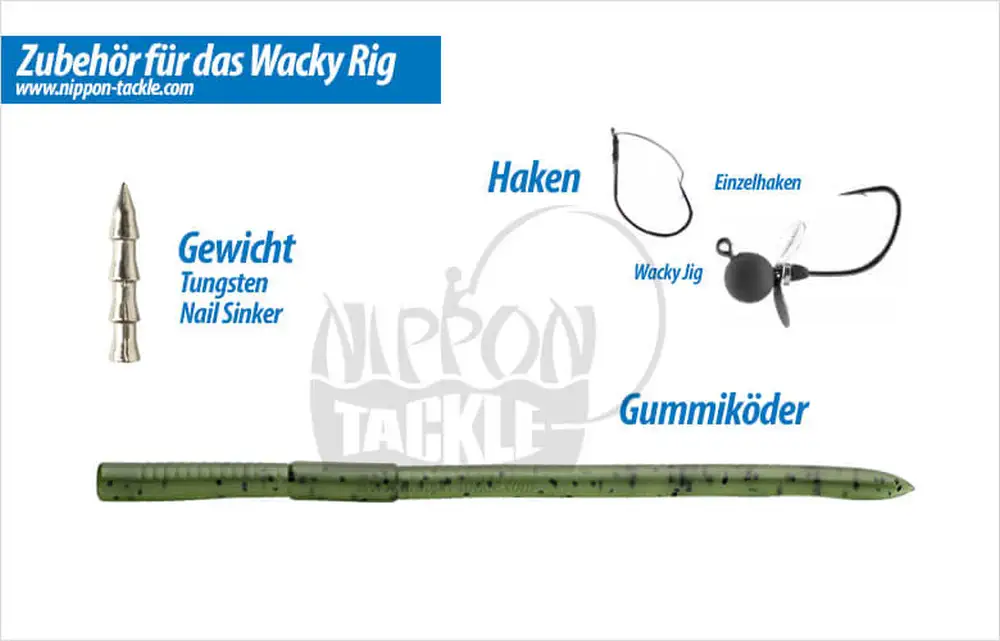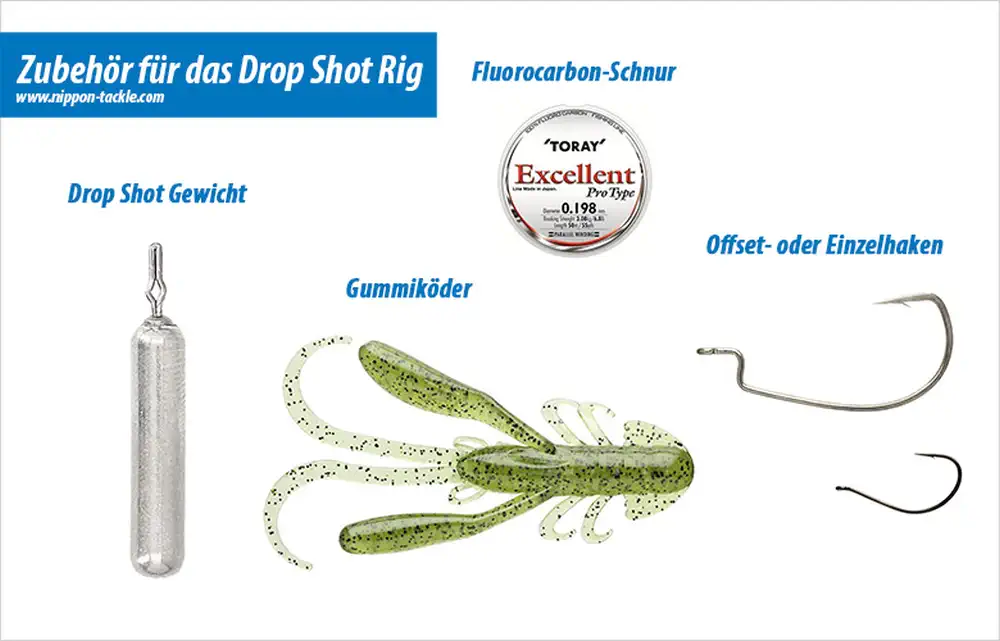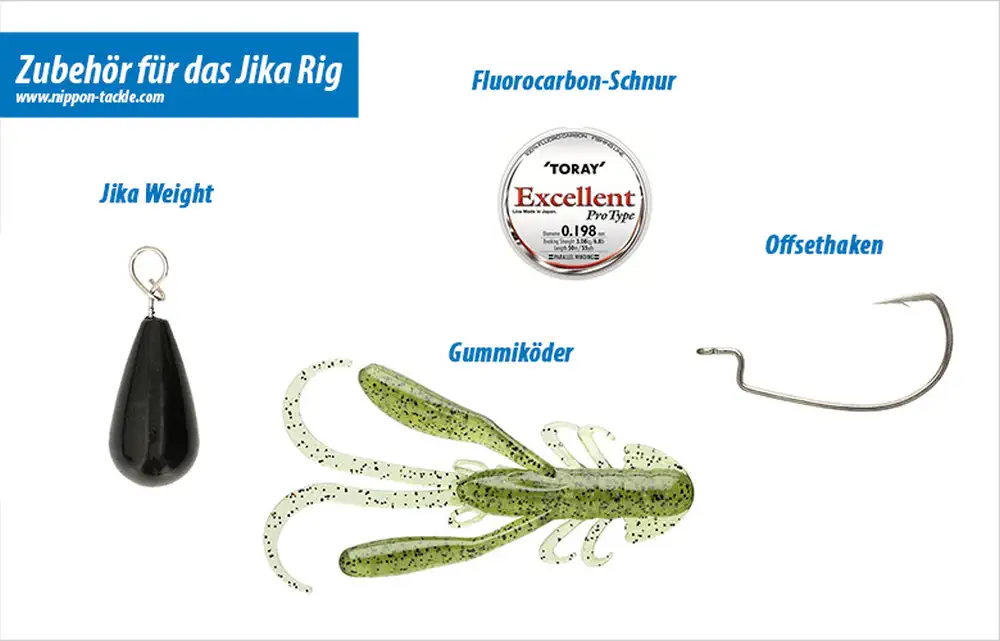Finesse Rigs
Texas-Rig
Depending on the size of the bait and the desired sink rate, so-called bullet weights made of tungsten are used on the Texas rig. Bullet weights are designed in such a way that they do not get stuck in the cover and have good flight characteristics. One of the core components of the Texas Rig is the bead. When the bullet weight hits the bead after the pluck or jig, a loud clicking sound is produced depending on the material of the bead. Glass beads click at a slightly higher frequency than sound beads made of synthetic material. A so-called bullet lock is pulled onto the line between the hook and the bead. This rubber stopper protects the knot from the bead.
Basically, all types of rubber baits can be fished on the Texas rig. If the rig is used in open water, for example, shads (rubber lures with a paddle tail) are often used. When fishing in heavy cover, on the other hand, creature baits and rubber crayfish are the lures of choice... read more
Carolina-Rig
The Carolina rig is essentially a modified Texas rig. The materials remain the same, but a bullet pin is added. The bullet pin ensures that the bead and bullet maintain a certain distance from the hook. This is the main difference to the Texas rig. The bullet pin allows you to flexibly change the length of your Carolina rig and you are not forced to tie time-consuming knots. Due to the distance between the mounting parts, the Carolina rig is less suitable for cover fishing than the Texas rig... read more
Spine-Rig
The simplest rigs are often the best! One of these fantastic finesse rigs for perch and trout is the Spine Rig. Super easy to rig and simple to guide, the running behavior of the rubber bait is particularly impressive due to its wide range of applications. From shallow water near the shore to vertically plucked rigs for perch and trout fishing - anything is possible with the Spine Rig!
All you need for the spine rig is a special hook, a tungsten nail sinker and the right rubber bait. In order to be able to react quickly to the preferences of perch and trout on the water, the spine rig can also be flexibly attached to the fluorocarbon leader with a snap. However, we recommend connecting it with a knot. This does not impair the running behavior of the finesse lures.
The nail sinker provides the required weight and affects the running behavior of the rig. The heavier the tungsten weight selected, the more aggressive the darting action of the soft bait. The heart of the spine rig is the “spine hook” specially designed by Fish Arrow. This is a small single hook with a rubber-like coating on the shank. The coating ensures that the hook sits firmly in the rubber bait even when the rig is pulled and cannot slip out.
Special lures are required to create the darted running behavior of the lures. The “spine” in the spine rig symbolizes the spine of a baitfish. Only relatively firm rubber lures are suitable for the spine rig... read more
Neko-Rig
The Neko Rig Master is the heart of the rig and the direct connection between the hook and the soft bait. To get the Neko Rig Rig to the desired depth, the rubber bait is weighted in the front or rear area using a weight.
With the light Neko Rig, only a tungsten nail sinker is used as a weight, which is inserted into the soft bait. This means that the lure reacts to even the lightest of tugs with seductive movements and glides gently back to the bottom after jumps. In the heavy version of the Neko Rig, a Neko Punch is also used and the nail sinker is replaced by a rig sinker of 3.5 to 10 g, which is threaded onto the spiral. This makes it possible to fish at greater distances and in deeper spots. The combination of Neko Punch and Rig Sinker with swivel keeps the bait very agile.
Suitable softbaits must have sufficient volume and a firmer material to securely attach the Neko Rig mast. Rubber crayfish, worms and creature baits are particularly suitable as they react very agilely to even the slightest tug... read more
Wacky-Rig
Whether the Wacky Rig is really an independent finesse rig, we will leave open at this point. Ultimately, the only thing responsible for the name is the type of baiting in the so-called “wacky style”. In this case, wacky means that the rubber bait is attached to the hook in a “crazy” way, which fundamentally changes the running behavior compared to normal baiting.
The weightless wacky rig is usually fished in shallow water areas without current or is used when the rubber bait used is equipped with the buoyancy property “sinking”. If no sinking rubber bait is available or the wacky rig is fished in deeper sections of water, the weighted wacky rig is used.
Special wacky hooks have an extra wide bend that is perfect for mounting on rubber worms. Wacky rig worms are relatively easy to recognize by a thickening, usually in the middle. This is where the hook is pierced, a nail sinker may be sunk into the bait and the hook is connected to the fluorocarbon line... read more
Drop-Shot-Rig
The drop-shot rig was specially developed for a slow and precise presentation. You should therefore adapt your bait presentation accordingly. This makes it suitable for hot spots where you suspect fish. The drop-shot rig is suitable for all our native predators. It is only important that you adjust the bait and hook size accordingly. The classics are of course perch and zander.
In contrast to the classic jig head, the bait is separate from the weight on the dropshot rig. This allows you to change the weight depending on the current, depth or activity of the fish without affecting the running behavior of the lure. In addition, the lure is permanently above the bottom - provided you keep enough tension on the line. This keeps it perfectly in the field of vision of the lurking predators.
You can either tie the hook directly onto the leader using a Palomar knot or use special DS hooks, which are mounted on a swivel and guarantee more movement. Leave approx. 30-50 cm of space between the hook and the weight. You need this distance so that the bait has enough distance from the bottom of the water despite the sharp angle from the bank... read more
Jika-Rig
The Jika rig is a very simple rig. All you need is a weight with an eyelet, a snap ring and a single hook. Pear-shaped weights are just as suitable as bar-shaped weights. The snap ring should have a relatively large diameter. This is because both the weight and the hook must fit inside it.
The Jika rig can be fished in a similar way to a classic jig head. The simplest method is jigging. In contrast to the jig head, the Jika rig has significantly more movement as the hook and weight are separate. Another option is to drag the jika rig along the bottom. The bait is held a few centimetres above the bottom and animated. At the same time, the weight stirs up sediment from the bottom. This imitates a bottom-dwelling fish.
You can take advantage of the separation of weight and single hook by letting your rig sink to the bottom and then applying tension to the line by holding the rod up. This will keep the jika rig upright and you can animate the weight and bait with light tugs. It twitches on the spot and performs small jumps. This is particularly effective if you know a hot spot where you are sure there will be fish... read more
Split-Shot-Rig
All you need for the assembly is a split-shot weight. This is simply clamped onto the leader. The split-shot rig is ready! Of course, you also need a single hook, which you attach to the end of the leader to present a softbait. The aim of the split-shot rig is to present your hookbait as inconspicuously and realistically as possible.
There are no limits to the lure presentation with this rig. However, its finesse makes it particularly suitable for natural presentation options. You can let the split-shot rig sink to a certain depth and then slowly reel it in with fine tugs. Another option is to let the rig bounce or drift/roll slowly over the bottom in running water. Due to its low weight, the splitshot rig is not designed for long casting distances. It is therefore suitable for targeting hot spots.
